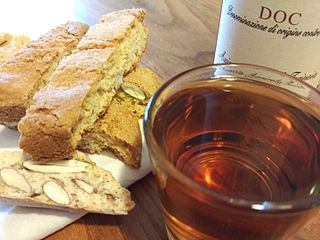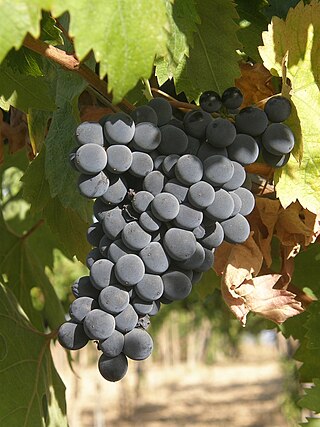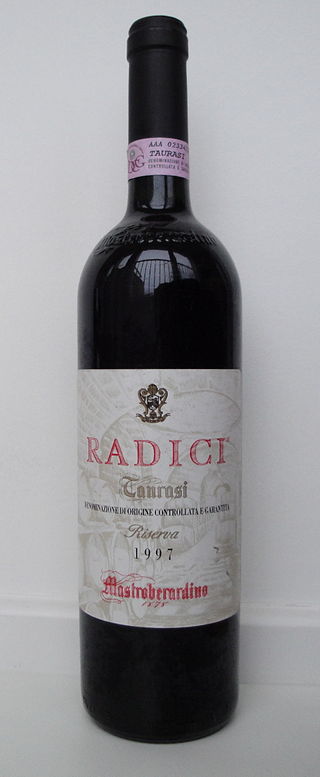
Chianti is an Italian red wine produced in the Chianti region of central Tuscany, principally from the Sangiovese grape. It was historically associated with a squat bottle enclosed in a straw basket, called a fiasco. However, the fiasco is now only used by a few makers of the wine; most Chianti is bottled in more standard-shaped wine bottles. In the latter nineteenth century, Baron Bettino Ricasoli helped establish Sangiovese as the blend's dominant grape variety, creating the blueprint for today's Chianti wines.

Barbera is a red Italian wine grape variety that, as of 2000, was the third most-planted red grape variety in Italy. It produces good yields and is known for deep color, full body, low tannins and high levels of acidity.

Sangiovese is a red Italian wine grape variety that derives its name from the Latin sanguis Jovis, "blood of Jupiter".

Brunello di Montalcino is a red DOCG Italian wine produced in the vineyards surrounding the town of Montalcino, in the province of Siena, located about 80 km south of Florence, in the Tuscan wine region. Brunello, a diminutive of bruno, is the name that was given locally to what was believed to be an individual grape variety grown in Montalcino. In 1879 the province of Siena's Amphelographic Commission determined, after a few years of controlled experiments, that Sangiovese and Brunello were the same grape variety, and that the former should be its designated name. In Montalcino the name Brunello evolved into the designation of the wine produced with 100% Sangiovese.

Italian wine is produced in every region of Italy. Italy is the country with the widest variety of indigenous grapevine in the world, with an area of 702,000 hectares under vineyard cultivation, as well as the world's second largest wine producer and the largest exporter as of 2023. Contributing 49.8 million hl of wine in 2022, Italy accounted for over 19.3% of global production, ahead of France (17.7%) and Spain (13.8%); the following year, production decreased by 11.5 million hl, and Italy was surpassed by France. Italian wine is also popular domestically among Italians, who consume a yearly average of 46.8 litres per capita, ranking third in world wine consumption.

Vin Santo is a style of Italian dessert wine. Traditional in Tuscany, these wines are often made from white grape varieties such as Trebbiano and Malvasia, although Sangiovese may be used to produce a rosé style known as "Occhio di Pernice" or eye of the partridge. The wines may also be described as straw wines since they are often produced by drying the freshly harvested grapes on straw mats in a warm and well ventilated area of the house. Although technically a dessert wine, a Vin Santo can vary in sweetness levels from bone dry to extremely sweet. While the style is believed to have originated in Tuscany, examples of Vin Santo can be found throughout Italy and it is an authorised style of wine for several denominazione di origine controllata (DOC) and indicazione geografica tipica (IGT).

Montepulciano d'Abruzzo is an Italian red wine made from the Montepulciano wine grape in the Abruzzo region of east-central Italy. It should not be confused with Vino Nobile di Montepulciano, a Tuscan wine made from Sangiovese and other grapes.

Montefalco Sagrantino is a style of Italian wine made with 100% Sagrantino grapes in and around the comune of Montefalco in the Province of Perugia, Umbria. The wines gained DOC status in 1979 as part of the Montefalco DOC and were later separately elevated to DOCG status in 1992 after a renewal of interest from winemakers, particularly Arnaldo Caprai. There are two DOCG wines: Montefalco Sagrantino Secco, an oak-aged dry red wine, and the less common Montefalco Sagrantino Passito, a sweet, dessert red wine.

Montepulciano is a red Italian wine grape variety that is most noted for being the primary grape behind the DOCG wines Colline Teramane Montepulciano d'Abruzzo and Offida Rosso; and the DOC wines Montepulciano d'Abruzzo, Rosso Conero, and Rosso Piceno Superiore.

Taurasi and Taurasi riserva are red, still Italian wines based principally on the Aglianico grape variety produced in the province of Avellino in the Campania region. They were awarded denominazione di origine controllata (DOC) status in 1970 and denominazione di origine controllata e garantita (DOCG) status in 1993. Produced less than 40 miles (64 km) from the other Aglianico stronghold of Aglianico del Vulture in Basilicata, the volcanic soils of the Taurasi region demonstrate the potential the Aglianico grape has to make wines on par with the Nebbiolo grape of Piedmont and Sangiovese grape of Tuscany. The popularity of the region's wine is a relatively recent phenomenon. Until the early 1990s, there was only one winery (Mastroberardino), producing wine for the export market. By the mid-2000s, there were over 293 producers in the Taurausi zone.

Tuscan wine is Italian wine from the Tuscany region. Located in central Italy along the Tyrrhenian coast, Tuscany is home to some of the world's most notable wine regions. Chianti, Brunello di Montalcino and Vino Nobile di Montepulciano are primarily made with Sangiovese grape whereas the Vernaccia grape is the basis of the white Vernaccia di San Gimignano. Tuscany is also known for the dessert wine Vin Santo, made from a variety of the region's grapes. Tuscany has forty-one Denominazioni di origine controllata (DOC) and eleven Denominazioni di Origine Controllata e Garantita (DOCG). In the 1970s a new class of wines known in the trade as "Super Tuscans" emerged. These wines were made outside DOC/DOCG regulations but were considered of high quality and commanded high prices. Many of these wines became cult wines. In the reformation of the Italian classification system many of the original Super Tuscans now qualify as DOC or DOCG wines but some producers still prefer the declassified rankings or to use the Indicazione Geografica Tipica (IGT) classification of Toscana. Tuscany has six sub-categories of IGT wines today.

Carmignano is an Italian wine region located in the Tuscany region and centered on the city of Carmignano, near Prato and about 10 miles northwest of Florence. Noted for the quality of its wines since the Middle Ages, Carmignano was identified by Cosimo III de' Medici, Grand Duke of Tuscany as one of the superior wine producing areas of Tuscany and granted special legal protections in 1716. In the 1800s, the producers of the Carmignano region developed a tradition of blending Sangiovese with Cabernet Sauvignon, long before the practice became popularized by the "Super Tuscan" of the late 20th century. In 1975, the region was awarded Denominazione di origine controllata (DOC) status and subsequently promoted to Denominazione di Origine Controllata e Garantita (DOCG) status in 1990. Today Carmignano has approximately 270 acres (110 ha) planted, producing nearly 71,500 gallons of DOCG designated wine a year.

The history of Chianti dates back to at least the 13th century with the earliest incarnations of Chianti as a white wine. Today this Tuscan wine is one of Italy's most well known and recognizable wines. In the Middle Ages, the villages of Gaiole, Castellina and Radda located near Florence formed as a Lega del Chianti creating an area that would become the spiritual and historical "heart" of the Chianti region and today is located within the Chianti Classico Denominazione di Origine Controllata e Garantita (DOCG). As the wines of Chianti grew in popularity other villages in Tuscany wanted their lands to be called Chianti. The boundaries of the region have seen many expansions and sub-divisions over the centuries. The variable terroir of these different macroclimates contributed to diverging range of quality on the market and by the late 20th century consumer perception of Chianti was often associated with basic mass-market Chianti sold in a squat bottle enclosed in a straw basket, called fiasco.
Abrusco is a red Italian wine grape variety grown primarily in the Tuscany region where it is a minor blending component permitted in the wines of Chianti. The grape has long history in the region and was mentioned in 1600, under its synonyms Abrostino and Colore, in the posthumously published work by Italian agronomist Giovan Vettorio Soderini Trattato della coltivazione delle viti, e del frutto che se ne può cavare. There Soderini notes that the grape was often used to add deeper, more red color to Tuscan wines.
Sovana is a denominazione di origine controllata red or rosé wine from the south of Tuscany, in Italy. The DOC is named after the ancient Etruscan settlement of Sovana. Sovana received DOC status in 1999, along with its neighbor, the DOC Capalbio. Sovana encompasses roughly the same areas that produce the white wine Bianco di Pitigliano, and encompasses the towns of Pitigliano, Sorano, Manciano and borders the DOC Morellino di Scansano in the north, and the region of Lazio in the south.
Verdea is a white Italian wine grape variety that originated in Tuscany but is today mainly grown in the Lombardy wine region of northern Italy. The grape is sometimes confused with the white Verdeca grape of the Apulia region and the French wine grape Verdesse from Savoy due to similarities in their names and synonyms. Verdea can be used to make a wide variety of wines, ranging from the late harvested Vin Santo to dry sparkling wines.
Negrara is a red Italian wine grape variety grown in north east Italy including the Veneto region where it is a permitted variety in the Denominazione di origine controllata (DOC) wine Amarone. While the grape was once more widely planted in the region its numbers have been steadily declining for most of the late 20th and early 21st century.

Abruzzo is an Italian wine region located in the mountainous central Italian region of Abruzzo, along the Adriatic Sea. It is bordered by the Molise wine region to the south, Marche to the north and Lazio to the west. Abruzzo's rugged terrain, 65% of which is mountainous, help to isolate the region from the winemaking influence of the ancient Romans and Etruscans in Tuscany, but the area has had a long history of wine production.

Montefalco wine is a style of Italian wine made in Umbria, and awarded Denominazione di origine controllata (DOC) status in 1979.

I Balzini D'Isanto is a wine estate in Italy, producing a Super Tuscan (wine), classified IGT, an official Italian classification designating the region of origin, rather than grape varieties or wine styles, allowing the use of foreign grape varieties to be added. The estates is owned by the D'Isanto family since 1980. The name "I Balzini" comes from the word "balze", the local name for the small terraces planted with vines.













